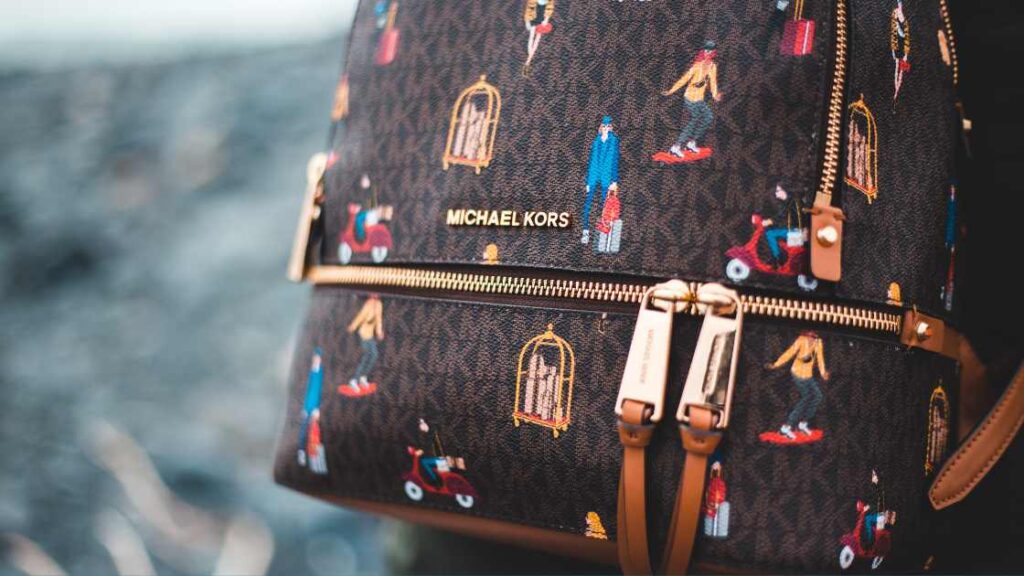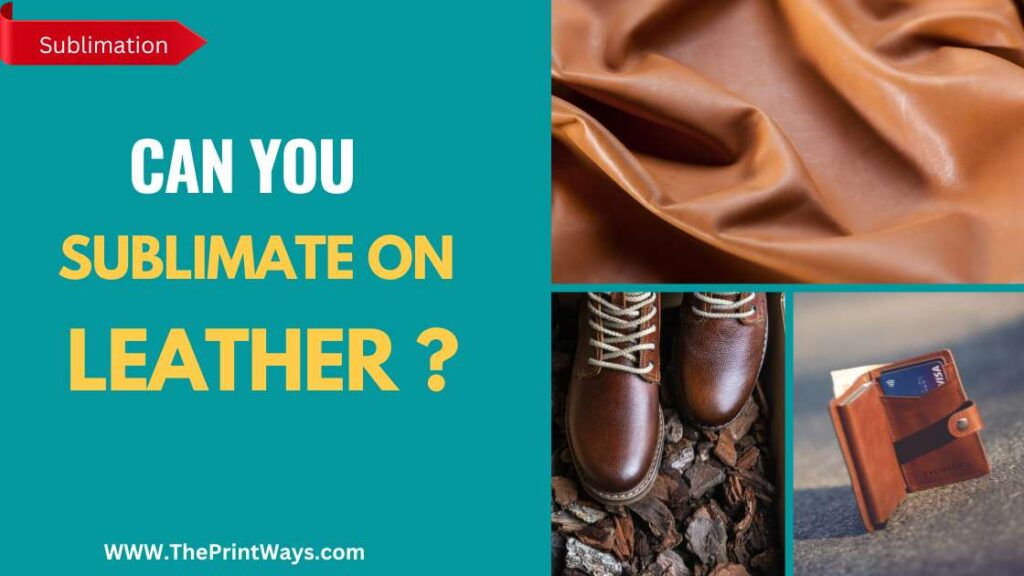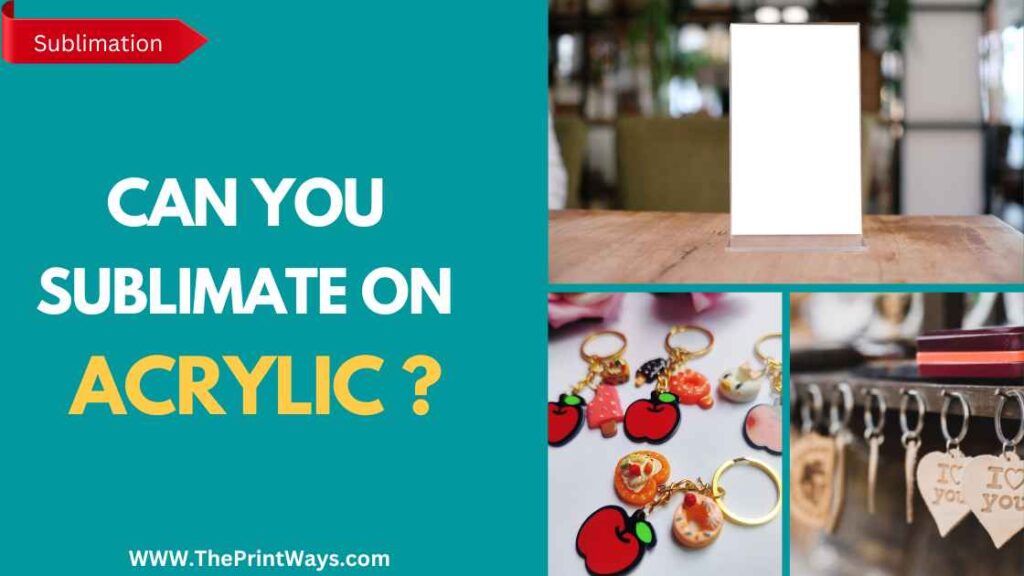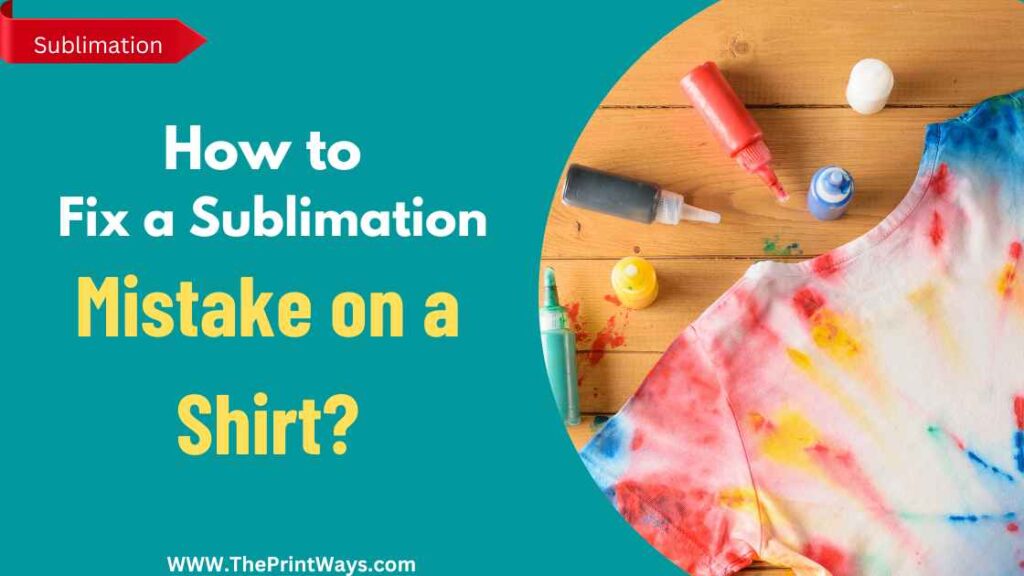Leather is an ageless and versatile material, used in everything from clothing and accessories to home furnishings. Because of its longevity, adaptability, and aesthetic value, it is frequently used in the creation of art and craft.
But what do you do when you want to embellish your leather goods with unique patterns? Can you sublimate on leather ?, and if so, what are the drawbacks and advantages?
Yes, You can sublimate on leather, and it’s a process that can add a distinctive and stylish touch to your leather goods.
In this article, we’ll dive deep into the topic of sublimation on leather, discussing the method, the supplies required, and some helpful hints for getting the best possible results.
Real leather Vs. Faux leather :Which is better ?
Despite their similarities in name, genuine leather and synthetic leather are two very different materials.
Real leather:

The skin of an animal, usually a cow, is used to create leather, a material that is both durable and environmentally friendly.
In addition to being long-lasting and airy, its distinctive texture and natural grain also lend it an air of elegance.
Leather can be treated to make it more water-, stain-, and wear-resistant. Leather, however, is both more costly and less eco-friendly than synthetic leather.
Popular: Can you Sublimate on Canvas Bags?
Faux leather:

Faux leather, also known as vegan leather or synthetic leather, is a man-made material that mimics the look and feel of genuine leather without using real leather.
Polyurethane, a kind of plastic, is frequently used to make it, and this material allows for a great deal of variety in terms of both colour and texture.
Faux leather is less expensive and more environmentally friendly than real leather, but it is not as long-lasting, breathable, or realistic looking.
Both genuine leather and synthetic leather are suitable for sublimation, though the end result may look different depending on the material and how it’s processed.
Sublimation on faux leather is generally more successful because its surface is more consistent and it does not absorb moisture as much as real leather would.
Sublimation on leather is possible even if its genuine, though it presents more of a challenge due to the surface’s inherent lack of uniformity and the potential for colour and texture variations.
Also Read: Can you Sublimate on Nylon?
Can you sublimate on Leather ? (Step-by-Step Tutorial)

As I mentioned above, Yes it is possible to sublimate on leather with a little effort. With right tools and process you will be able to sublimate on most of the leather made products like Wallets, Bags, Jackets etc.
Related : How to print on Leather ?
Required Supplies
- Leather ( Real or Synthetic )
- Sublimation Ink
- Sublimation Paper
- Heat Press
- Transfer Tape
- Image or design
- Printer
- Protective Paper
Step 1. Selecting the right leather
It is essential to select the proper type of leather for sublimation before beginning the procedure. Try to find genuine leather or bonded leather, both of which are high-quality options, and are made with sublimation in mind.
Sublimation ink can be used to create an everlasting and vivid image on smooth, porous leathers. In order to get the best results from the sublimation process, you should not use synthetic leathers or suede.
Step 2. Cleaning the leather surface
In order to get the best results from the sublimation printing process, you need clean the leather product thoroughly before you start.
Start with a soft cloth and leather prep spray or a leather cleaner made for sublimation. If you do this, the surface will be more likely to be flat and suitable for printing.
Step 3. Designing and printing the image
To produce your image, you’ll need a sublimation printer, special ink cartridges, and design software like Adobe Illustrator or CorelDRAW.
Ensure that the image is printed backwards so that it can be transferred accurately onto the leather. For best results, use heavyweight (68-72gsm) sublimation paper made for this purpose and optimised for sublimation ink.
Step 4. Heat transfer
Make sure the printed sublimation paper is straight and centred over the leather good. Make sure the paper doesn’t budge during the transfer by taping it down using heat-resistant tape.
Heat press the leather item and the sublimation paper for the specified amount of time at the specified temperature.
While the specifics of time and temperature will vary depending on the leather item and sublimation paper used, 60–90 seconds at 385–400°F is a good rule of thumb.
Step 5. Removing the paper
Carefully peel off the sublimation paper from the leather item once the transfer process is complete. Use a soft cloth to gently wipe away any residue that may have been left on the leather.
Do not clean the leather or the sublimated image with water or any other cleaning products.
Step 6. Finishing the product
When the leather item has cooled fully, you can examine it for flaws. Refine the image using leather paint or markers as needed.
The application of a leather protectant is also recommended to prevent the picture from being faded or damaged over time.
Testing and quality control
It’s recommended to run a small scale test of your sublimated leather products before going into full production. Using this information, you can fine-tune the procedure and achieve the besCan yt possible outcomes.
Additionally, you can ensure that the sublimated image is of high quality by inspecting its coloration, brightness, and longevity.
Thats it for now . These are the simple step to sublimate on Leather. But in some cases you might not want to sublimate on leather.
You can consider printing on leather with different methods like Screen printing on leather, Heat transfer on Leather and Digital printing on Leather.
Can you sublimate on Faux Leather?
Sublimation on faux leather or synthetic leather is also possible, but the method may slightly differ from that used for genuine leather.
The surface structure and texture of faux leather are designed to mimic those of genuine leather, but the two materials are artificial. For this reason, optimal circumstances for sublimation may vary.
Selecting a high-quality faux leather made for sublimation is essential when working with faux leather for sublimation.
The quality of the sublimated image can be affected by the imitation leather type used, as certain varieties of faux leather have a more porous surface than others.
While the process of sublimating on fake leather is almost similar to that used on real leather, slight adjustments to heat, time, and pressure may be required. Use sublimation paper and ink intended for use with imitation leather for the best results.
Also, be gentle when removing the sublimation paper from the imitation leather surface after the transfer process. Some types of imitation leather are more fragile than genuine leather and can easily be damaged by hard treatment.
You May Like: How to Sublimate on Wood?
Frequently Asked Questions
Q: Which type of leather is best for sublimation ?
Ideally, sublimation should be performed on smooth, fine-grained leather that lacks any textural patterns. Sublimation works best on untreated, full-grain leather because of its uniform grain pattern and lack of rough spots.
Nappa or Napa leather that has been properly prepared can also work, provided it is of high enough quality and devoid of any surface coatings that might prevent the sublimation process from working properly.
Q: How can I ensure that my leather sublimates in the best possible conditions?
Sublimation on leather requires a very exact combination of heat, pressure, and time in order to be successful. For optimal results when sublimating onto leather, the temperature should range from 365°F to 385°F, and the pressure should be around 55 psi. Time needed for sublimation on leather varies with both the product and the type of leather being utilised.
Q: Is it possible to sublimate on leather products like Wallet and handbags ?
Wallets and purses made of leather can have graphics sublimated onto them. Numerous leather goods, such as wallets, bags, keychains, and so on, benefit from the sublimation printing method.
A design is first printed onto sublimation paper, which is then heated and pressed to transfer the design onto the leather good.
Q: As opposed to other materials, what are the advantages of sublimation on leather?
When compared to other materials, sublimation on leather provides a number of advantages. The sublimation method is advantageous because it produces high-quality graphics that last a long time without deteriorating or peeling.
Leather’s natural, high-end appearance and feel make it a great material for a wide range of luxury goods. Sublimation on leather also has no setup fees or minimum order restrictions, making it a flexible and affordable choice for both small and big production runs.
Final Thoughts
Sublimation on leather is a versatile, low-cost, and aesthetically pleasing option for making custom leather goods like wallets, bags, and keychains. If you’re wanting to make high-end goods, leather is a great material to work with because of its inherent elegance and resilience, and because sublimation allows you to create designs of exceptional quality that will last for years. I hope this guide helped you understand the process of sublimation on leather. Stay tuned for next tutorial !





